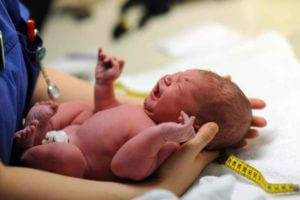Puerperal fever is a consequence of postpartum congestion. If the wound secretion cannot flow freely after birth, dangerous inflammations occur in the abdominal area. This can even lead to blood poisoning, which actually killed many young mothers in earlier times.
The main reason was a lack of hygiene. Therefore, many modern mothers believe that puerperal fever cannot affect them. But this is a dangerous misconception, because even today an undetected infection of this kind can be fatal.
One thing to reassure you in advance: a lot has to go wrong before it gets that far. Normally, doctors recognize puerperal fever immediately and get it under control quickly with the help of antibiotics.
Table of contents
What Is Puerperal Fever?
After birth, you have a wound in your body. Your body now rejects everything that it no longer needs. This is mainly the placenta, but also the remains of the egg membranes. However, your body normally manages to treat the wound on its own. This works with the help of the so-called lochia.
This is a highly infectious secretion of bacteria and dead tissue. If it does not drain properly, inflammation occurs – puerperal fever, Latin for puerperal sepsis.
So puerperal fever and puerperal sepsis mean the same thing. In these days and weeks after birth, your cervix is still dilated. Therefore, during bacteria can rise more easily and cause an infection in your abdomen.
- Also interesting:
- The best baby bottles
- Recommended slings
- The best cotton candy machines
Causes are different strains, such as coli, streptococci or even staphylococci. They can cause dangerous infections, which are grouped under the term puerperal fever. The cause is not always the same, but it always has to do with postpartum flow.
Puerperal congestion as a trigger of puerperal fever.
The postpartum flow (lochia) continues to flow for weeks after birth, carrying away anything that could endanger your body. This allows the wound to heal in peace. You should not stop it under any circumstances, because it fulfills an important function: It is part of your personal hygiene. Let it flow as freely as possible to prevent a back-up.
Postpartum congestion is characterized by low or absent weekly flow. Because this prevents dangerous pathogens from getting out of your body, the risk of infection increases rapidly. Other names for lochia are lochial congestion or lochiometra.
Puerperal Fever – Is It Contagious?
This type of infection is a natural reaction in your body. It is not less dangerous, but only for you as a mother. If you are afraid of infecting an infant with fever, you do not have to worry about it.
However, if puerperal fever and fever occur at the same time in the infant, it is pure coincidence. Fever in a toddler can have many causes. Don’t know how to take a fever in a toddler? Here’s a helpful guide on how to do it!
How Does Puerperal Fever Develop?
This is an inflammation in the abdomen, as a result of which even blood poisoning (sepsis) can occur. The place where it happens is the uterus: after all, the lining of the uterus is still sore after birth.
This wound must heal! In the process, it naturally secretes wound secretions. This is a mixture of tissue, bacteria, white blood cells and even vaginal secretion.
If this is accumulated, it leads to inflammation of the surrounding tissue. Postpartum congestion can thus cause various inflammations. First and foremost is peritonitis, but inflammation of the fallopian tube and ovaries is also common.
But the endometrium itself can also become inflamed. Finally, sepsis can occur if bacteria enter the blood through the uterine wound.
Risk Factors For Puerperal Fever
- Perineal incision, perineal tear
- Cesarean section
- Afterbirth incompletely expelled
Is Puerperal Fever Always Life-threatening?
Puerperal fever always puts the young mother’s life in danger. That is why action must be taken as soon as possible! True, the danger may not be as great today as it once was. But the infection itself, once it breaks out, can be fatal.
Does Puerperal Fever Mean I Was Negligent?
No. Because, unfortunately, the risk can never be reduced to zero. The reason: Immediately after birth, your cervix is still wide open. That’s just the way it is and there’s nothing you can do about it.
It will only change within the first few days after the birth. Until then, you must always expect that germs will rise through the still existing direct connection: Your vagina is still directly connected to the uterus.
So puerperal fever is not always related to poor hygiene, even if this is still the most common cause.
Other Possible Causes Of Puerperal Congestion
- Narrowed or closed cervix: for example, after cesarean section.
- Blocked channel between the inner and outer cervix: egg membrane remains cannot be drained off.
- Kinked cervix: postpartum flow cannot drain through vagina.
- Overfilled rectum, overfilled bladder.
Postpartum Congestion And Puerperal Fever – When Is The Danger Over?
The danger exists until the postpartum flow is over. How long wound secretions continue to drain also depends on how quickly your uterus heals. In total, this can take up to six weeks. During this time, you will notice changes in your postpartum flow that affect color, odor, and consistency.
Puerperal Fever Throughout History
Puerperal fever has been around since the dawn of mankind. However, it was not until 1861 that the famous physician Ignaz Semmelweis defined it as an infectious disease. Puerperal fever was a deadly affair until then.
Survival was a matter of luck. The causes at that time were poor hygienic conditions and ignorance about it. In addition, women of the lowest classes often had no time to recover properly during the puerperium.
It is true that as early as the nineteenth century there was a suspicion that it might be a disease related to germs. The reason for this was the then new maternity wards in hospitals, which drove up the infection rate.
It was discovered quite early on that a particularly large number of germs were transmitted here. Progressive doctors tried to counteract this with better hygiene. However, many women still died at home rather than in the hospital. It was not until the invention of antibiotics that a real remedy was found.
To this day, they are the only effective antidote. If you take antibiotics at the first sign of puerperal fever, you can prevent it from developing.
Thus, not only hygiene is important for effective control, but also a good medical infrastructure. This is what makes it so difficult to combat in the developing world: in African countries, for example, one in a hundred women still dies in childbed. Puerperal fever is probably one of the most common causes of this.
Puerperal Fever Is Not The Same As Fever In Infants
In Western countries, we have a very different problem. Because it is so rare, some young mothers no longer know what puerperal fever even is. In the past, every woman had a case in her immediate neighborhood; today, education is needed.
For example, there is a widespread belief that it refers to a fever in an infant. Responsible for this is the name, which seems to point to an illness in the child’s bed. However, fever in infants has very different causes, while the dreaded puerperal fever exclusively affects the mother in her very special situation.
Recognizing Puerperal Fever: Signs Of Puerperal Fever
Up to seven days after birth, you are particularly at risk. Then you suffer from fever > 38 ° Celsius. Abdominal pain tells you that something is wrong. In addition, you have little to no postpartum flow.
If there is anything at all, it smells unpleasant. Other symptoms include headaches that you can’t explain. Often, those affected suffer from a stabbing forehead headache, starting from the temples. Earaches are also possible.
Childbed Fever – This Is How You Recognize It:
- Bad odor of the wound flow.
- No more postpartum flow / unusually heavy bleeding.
- Fever, headache.
- Nausea up to vomiting.
- Painful pressure in the abdomen.
- Severe fatigue, sleep disturbances, depression.
If you do not act now, the symptoms will intensify. Complications may arise and at some point you will go into shock.
Suspicion Of Puerperal Fever? This Is What You Have To Do!
Call A Midwife / Doctor Immediately
Immediate action saves lives. Puerperal fever can still be fatal! The specialist decides whether you need to go to the hospital. It depends on how advanced the infection is.
Childbed Fever Therapy: What Does The Doctor Do?
At the beginning there is always a thorough examination. Ultrasound and palpation are good ways to diagnose puerperal congestion. Depending on the case, this is usually followed by a combination of different medications that dissolve the lochia.
- Antispasmodic drugs relax the cervix.
- Drugs that induce postpartum ensure that the flow is renewed.
- Antibiotics help against an impending or existing infection.
In addition, the doctor often gives an active substance called methylergometrine. This promotes regression: the faster the cervix closes again, the sooner the risk of contracting puerperal fever is over.
Preventing Puerperal Fever
Nature is strong and can heal many things on its own. But you should support it as much as you can. Hygiene always comes first! But also good self-monitoring and plenty of rest during the postpartum period. After all, important things happen during this time.
- Regression
- Wound healing
- Recovery
Read more here about what you can expect during the postpartum period.
Puerperal Fever: How To Prevent It
You can ensure good hygiene during the postpartum period by fighting germs. They should not have a chance to settle anywhere. Problems arise especially if the bacteria migrate back and cause an inflammation.
The first few days after birth are especially tricky. The more the wound heals, the safer you are! To ensure good hygiene, there are a few basic things you should pay attention to.
Hygiene In The Postpartum Period Prevents Puerperal Fever
- Change pads at least every three hours. Keep this up until two weeks after birth, after which less frequent replacement is sufficient.
- Tampons remain in the package for the time being! They would prevent free puerperal flow .
- Showering: very often possible.
- Bathing: Also refrain from bathing for the time being. It makes it easier for germs to rise!
- Rinse intimate area: recommended. Possible before or after going to the toilet. Put an extra cup ready, which you fill with lukewarm water. Always rinse only externally!
- Sex must first wait, because this is a possible source of infection.
Don’t forget your postpartum exercises. Everything that supports the regression accelerates the healing process. Do not stay in love for a long time after the birth, but try to be mobile again as soon as possible.
By the way, if you breastfeed your baby, you stimulate the release of oxytocin. This in turn leads to increased contraction of the uterus, which promotes postpartum flow.
What To Do In Case Of Puerperal Fever And Postpartum Congestion
The first thing to do is to see a doctor! Afterwards, you should allow yourself plenty of rest. Light massages of the lower abdomen and heat can also be helpful. However, discuss everything you want to do with your doctor.
Under observation and with the right treatment, the symptoms will subside within a few weeks. Only in the rarest cases does surgery have to be performed.
If you have postpartum congestion, drink plenty of fluids. Treat yourself to a hot water bottle from time to time. Take care to rest despite the baby. Of course, it is bad if the baby has a fever at the same time. Then ask your partner or grandparents for help, because you should not overexert yourself now.
Conclusion On Puerperal Fever
In the past, puerperal fever represented one of the most common causes of death in young mothers. Today, we have this insidious infection under control: with the help of improved hygiene and a good knowledge of the processes, even such a disease can be treated quickly and effectively.
But in the process, the knowledge about it is lost. Therefore, many young mothers are no longer well informed and believe that it is a type of fever in infants. However, puerperal fever has nothing to do with fever in a toddler.
Rather, it is an infection that rises in the abdomen due to disturbed postpartum flow. If this cannot flow off unhindered, the infectious mixture spreads through the body. This must be prevented urgently, otherwise it becomes dangerous.
Antibiotics, which stop the incipient inflammation, are the main source of help. Therefore, even if symptoms are unclear, such as fever or headache, the doctor should always be informed in order to prevent something worse!













1 thought on “Puerperal Fever: How To Prevent The Dangerous Disease In The Postpartum Period”